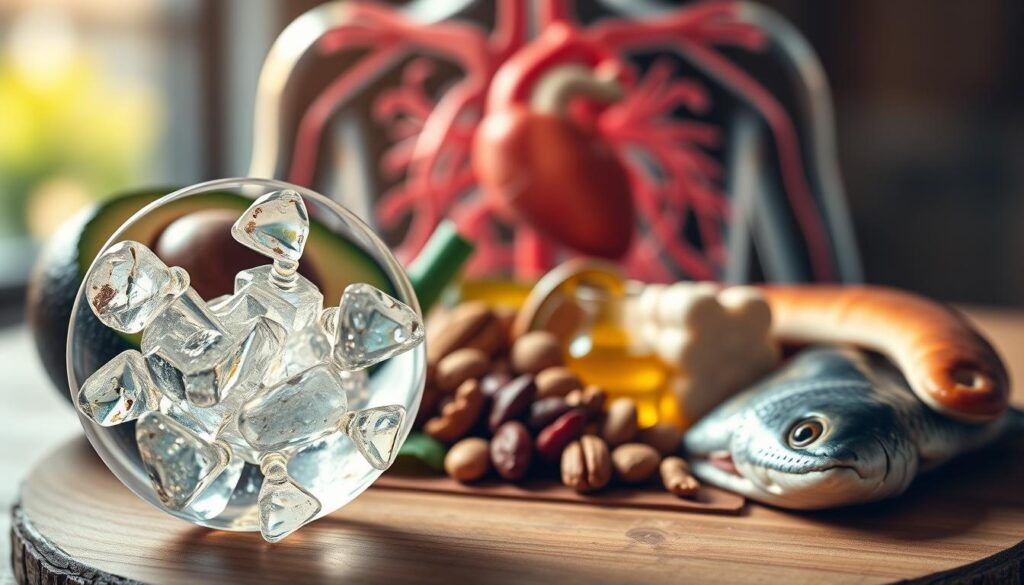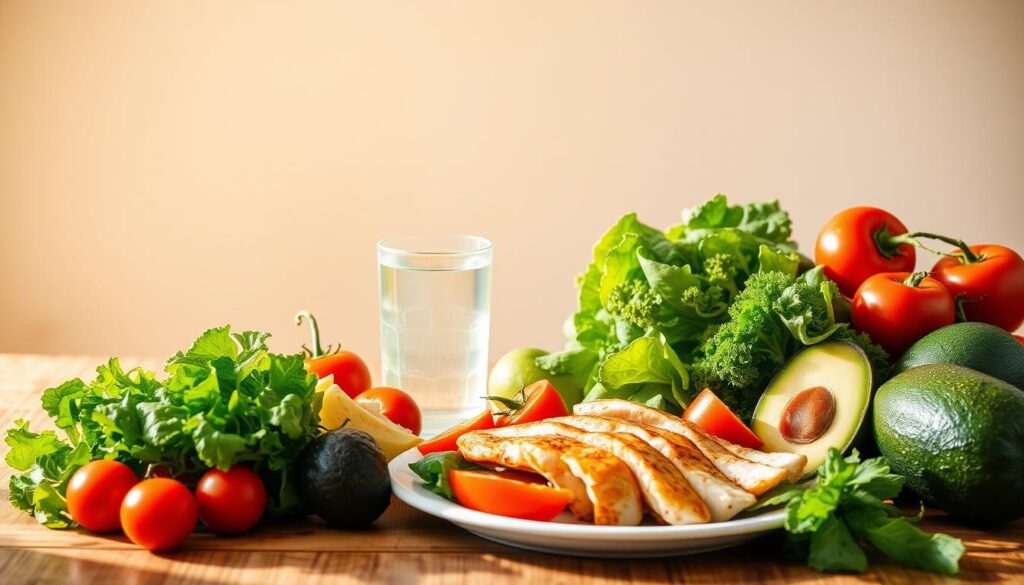
Are you struggling with high cholesterol that’s hard to manage? What if changing your diet could improve your heart health without needing medicine?
High cholesterol is a big problem worldwide, affecting millions. A low-fat diet is a strong way to naturally control cholesterol and keep your heart safe.
Managing cholesterol isn’t all about pills. Eating right can greatly improve your blood fats. This can lower harmful cholesterol and stop heart problems.
This guide will show you how to fight high cholesterol with food. We’ll look at the science behind nutrition. You’ll learn how to choose foods that are good for your heart.
By linking diet to cholesterol, you’ll see how small changes can make a big difference. You’re about to find a new way to care for your heart that’s different from usual treatments.
Understanding the Link Between Dietary Fat and Cholesterol Levels
Managing cholesterol is key to a healthy heart. The link between dietary fat and cholesterol is complex. Knowing how fats affect triglycerides and cholesterol can guide better food choices.

The Science Behind Cholesterol Production
Your body makes cholesterol in the liver. It’s vital for hormones, vitamin D, and cell membranes. While your body makes most cholesterol, what you eat also matters. Some foods help boost HDL or lower LDL, making diet a strong tool in managing cholesterol.
Different Types of Dietary Fats and Their Impact
- Saturated Fats: Found in animal products, they can increase LDL cholesterol
- Unsaturated Fats: From plants, they can improve cholesterol levels
- Trans Fats: Artificial fats that harm cholesterol and heart health
How Your Body Processes Cholesterol
Cholesterol moves in the body through two main lipoproteins:
| Lipoprotein Type | Function | Impact on Health |
|---|---|---|
| HDL (High-Density Lipoprotein) | Removes excess cholesterol from bloodstream | Considered “good” cholesterol |
| LDL (Low-Density Lipoprotein) | Carries cholesterol to body tissues | Can lead to arterial plaque buildup |
Choosing the right diet can greatly affect triglycerides and cholesterol. By grasping these complex processes, you can pick foods that support heart health.
Benefits of Following a High Cholesterol Low Fat Diet

Starting a high cholesterol low fat diet can change your health for the better. It offers many benefits for those looking to lower cholesterol in just 7 days. This diet is more than just food; it’s a way to improve your overall well-being.
Plant-based nutrition is key in managing cholesterol. Eating more plant-based foods can greatly improve your health.
- Rapid cholesterol reduction within one week
- Enhanced cardiovascular health
- Natural weight management
- Improved metabolic functioning
This diet does more than just lower cholesterol. People who eat more plants often feel more energetic, have better digestion, and less inflammation.
| Diet Benefit | Impact |
|---|---|
| Cholesterol Reduction | Up to 10-15% decrease in 7 days |
| Heart Health | Decreased risk of cardiovascular diseases |
| Weight Management | Natural calorie control |
Choosing nutrient-rich, plant-based foods can help manage cholesterol and support health. The path to better health starts with careful food choices.
Essential Components of a Heart-Healthy Low-Fat Diet
Creating a low-fat diet menu for heart health means making smart food choices. Knowing the right nutrients can change how you manage cholesterol through diet.
For a cholesterol-friendly diet, pick foods that help your heart. It’s about finding the right balance and cutting down on bad fats.
Plant-Based Protein Sources
Switching to plant-based proteins can boost your cholesterol health. Here are some high-protein options:
- Lentils and beans
- Quinoa
- Tofu and tempeh
- Chickpeas
- Nuts and seeds
Fiber-Rich Foods for Cholesterol Management
More fiber means lower cholesterol. Here are some high-fiber foods:
| Food Category | Fiber Content |
|---|---|
| Oatmeal | 4 grams per serving |
| Chia Seeds | 10 grams per ounce |
| Raspberries | 8 grams per cup |
| Pears | 5.5 grams per medium fruit |
Omega-3 Rich Foods to Include
Omega-3 fatty acids are great for heart health and cholesterol. Here are some top choices:
- Salmon
- Mackerel
- Sardines
- Flaxseeds
- Walnuts
Pro tip: Make sure to add these foods to your low-fat diet menu often for better cholesterol control.
Foods to Avoid for Better Cholesterol Management
Understanding which foods can harm your heart health is key to managing cholesterol. A low-fat low cholesterol diet pdf can help you spot foods that raise cholesterol levels.
- Red and processed meats
- Full-fat dairy products
- Fried and deep-fried foods
- Baked goods with trans fats
- Packaged snacks high in saturated fats
Saturated and trans fats are the main culprits in raising bad cholesterol. These fats can increase LDL (bad) cholesterol and lower HDL (good) cholesterol.
“Your diet plays a crucial role in managing cholesterol levels and protecting heart health.” – American Heart Association
Unhealthy fats can hide in unexpected foods. Commercial baked goods, pre-packaged meals, and some oils may have high cholesterol-raising ingredients.
| Food Category | Impact on Cholesterol | Recommendation |
|---|---|---|
| Processed Meats | High Cholesterol Risk | Limit or Avoid |
| Whole Milk Products | Increases LDL | Switch to Low-Fat Options |
| Commercial Pastries | Contains Trans Fats | Eliminate from Diet |
For a detailed guide on managing cholesterol through diet, download a low-fat low cholesterol diet pdf. It offers nutritional advice and meal planning strategies.
Practical Tips for Transitioning to a Low-Fat Diet
Changing your diet can seem tough, but with the right steps, you can do it. A low-fat diet helps manage cholesterol. It requires planning and making smart food choices.
Having a clear plan makes dietary changes easier. A detailed low-fat diet food list pdf is a great tool for your journey.
Meal Planning Strategies
Good meal planning is key for a low-fat diet. Here are some important tips:
- Plan your meals for the week ahead
- Keep your kitchen stocked with healthy foods
- Make meals balanced with lean proteins and veggies
- Use portion control
Healthy Cooking Methods
Choosing the right cooking methods can cut down fat while keeping food tasty:
- Grill instead of frying
- Steam your veggies
- Bake lean proteins
- Use non-stick pans
Reading Food Labels Effectively
| Label Component | What to Look For |
|---|---|
| Total Fat | Less than 3g per serving |
| Saturated Fat | Less than 1.5g per serving |
| Cholesterol | Less than 20mg per serving |
Learning to read food labels helps you make better choices. This supports your heart-healthy eating goals.
Pro tip: Download a reliable low-fat diet food list pdf. It makes grocery shopping and meal planning easier.
Conclusion
Managing high cholesterol through a low fat diet is more than just eating. It’s a big step for your health. Understanding how food affects your heart is the first step.
Heart-healthy eating is about making smart food choices. Eating more plant-based proteins, fiber, and omega-3s helps manage cholesterol. It’s about eating well for the long term, not just for now.
Getting advice from doctors is key when changing your diet. Everyone’s health is different. Doctors can give you a plan that fits you.
Starting to manage your cholesterol is all about small steps. See a low fat diet as a chance to try new, healthy foods. With time, patience, and effort, you can improve your health.
FAQ
How quickly can a low-fat diet help lower cholesterol?
Starting a low-fat diet can show cholesterol improvements in 4-6 weeks. Some see changes in just 7 days. This is true when you also exercise regularly and cut down on saturated fats.
What are the best plant-based protein sources for a low-fat diet?
Great plant-based proteins are legumes like lentils and chickpeas. Also, tofu, tempeh, quinoa, edamame, and almonds are good. They offer protein and help with cholesterol by adding fiber and nutrients.
Can I still eat meat on a low-fat diet for cholesterol management?
Yes, but pick lean meats like skinless chicken and turkey. Fish, like salmon, is also good. Limit red meat and choose smaller portions. Try to eat more plant-based proteins.
How much fiber do I need daily to help lower cholesterol?
You should aim for 25-30 grams of fiber a day. Soluble fiber is best for cholesterol. Foods like oats and fruits can help lower bad cholesterol and support your heart.
Are all fats bad for cholesterol?
No, not all fats are bad. Healthy fats in olive oil and avocados can improve cholesterol. They increase good cholesterol and lower bad cholesterol.
What cooking methods are best for a low-fat diet?
Use heart-healthy methods like steaming and baking. Avoid deep-frying. Use non-stick pans or a little olive oil to cut down fat.
How can I effectively read food labels to manage cholesterol?
Look for low saturated and trans fats on labels. Choose foods with high fiber and natural ingredients. Be mindful of serving sizes and total fat content.
Can supplements help lower cholesterol alongside a diet?
Supplements like fish oil might help. But talk to a doctor before taking them. Diet and lifestyle changes are still the best approach.
What are the most important foods to avoid for cholesterol management?
Avoid foods high in cholesterol and saturated fats. This includes full-fat dairy and processed meats. Choose whole grains, fruits, and lean proteins instead.
How often should I have my cholesterol checked while on a low-fat diet?
Get your cholesterol checked every 4-6 months. This helps track your progress and allows for diet adjustments or medical help if needed.
